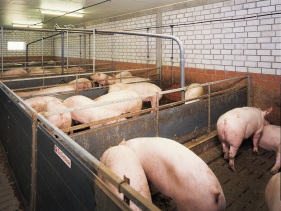Triticale liquid feeding beneficial to pig sector

Feeding triticale as a liquid feed may well prove to be a method that not only increases pig growth, but also reduces nutrient losses to the environment and improves the environment on the farm.
It sounds almost too good to be true: a feeding method that improves the situation for both the environment and the pig farmer.
This may nevertheless prove to be the case if the scientists’ hypotheses about feeding triticale in liquid feed to pigs hold true. Now these hypotheses are going to be put to the test.
“We have an idea that nutrients – especially N and P – are better assimilated and utilized in pigs when the grain has been soaked than when it is dry,” says head of research unit Hanne Damgaard Poulsen from the Department of Animal Health and Bioscience at the Faculty of Agricultural Sciences, Aarhus University in Denmark.
“We also have some ideas about the reasons for this and we have an idea that triticale is better suited for this purpose than barley, wheat and rye. But we have very little actual knowledge about this, so we will undertake some experiments to prove or disprove our theories.”
Liquid feeding is a boon
Liquid feeding for pigs is becoming ever more popular. Not only does it help to reduce dust levels indoors, it is also a more labour-friendly procedure.
Evidence suggests that there are also benefits for the environment – and for pig growth – with liquid feeding.
It would appear that the absorption and utilization of nutrients – including P and protein and thus N – improves when the grain is wet.
If there is an improvement in the absorption and utilization of N and P, this is significant for both pigs and the environment.
The pigs have a better growth rate because they can utilize the feed better. And it is better for the environment because of the lower risk of nutrient surplus losses from pig production.
Pre-digestion
Scientists believe that the increased digestibility may be due to increased enzyme activity in the nucleus of the grain.
This means that the digestion of cereal actually begins even before it reaches the pig’s stomach. This suggests that for triticale in particular a very active pre-digestion takes place in the liquid feed.
Initially, the scientists will examine how different varieties of triticale perform under simulated liquid feeding conditions in the laboratory. Here it is possible to adjust factors such as incubation time, temperature and pH.
On the basis of these results, the triticale varieties will be classified and evaluated. Selected varieties will subsequently be used for indoor feeding experiments on pigs to compare the digestibility of liquid and dry feeding with triticale.
“If our hypotheses are correct, liquid feeding with enzyme-rich and high-yielding varieties of triticale may be a promising tool in the continued improvement of particularly the utilization of proteins – and hence of nitrogen and phosphorus. This will have a major positive environmental impact,” says Damgaard Poulsen.











